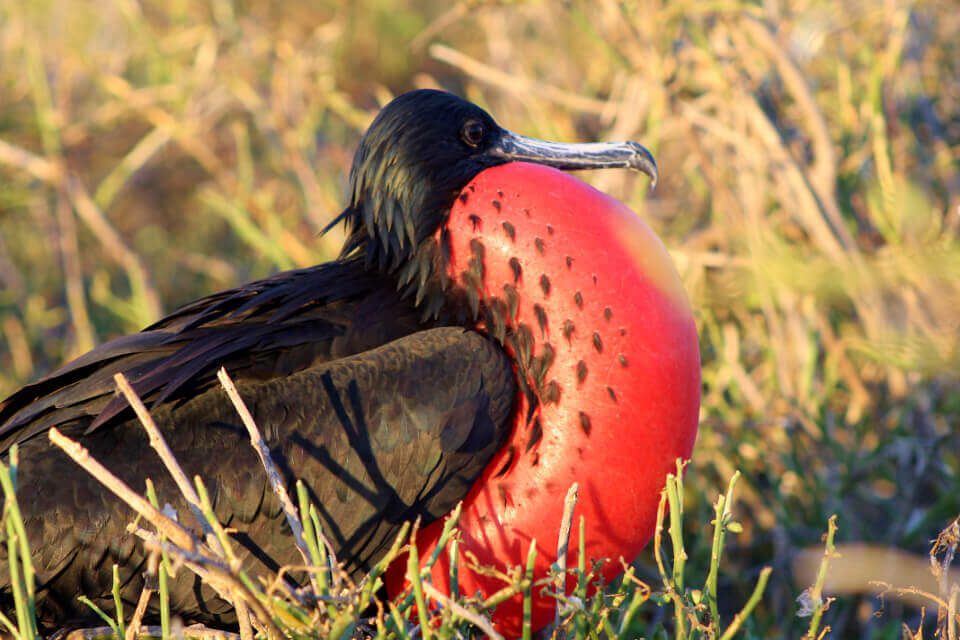WHERE IN THE GALAPAGOS CAN I FIND FRIGATEBIRDS?
There are frigatebirds around the Galapagos Islands. The San Cristobal Islands, North Seymour, and Genovesa are ideal locations to witness them in action. These are excellent locations to see spectacular and great frigate birds. Many frigatebirds visit a freshwater lake, particularly in the San Cristobal mountains, to rinse the salt from their wings. They plunge into the volcanic crater lake’s freezing water for a split second before veering back into the sky. After contact with ocean water, bathing helps prevent the birds’ wings from becoming saturated and totally of salt.
A frigatebird attempting kleptoparasitism may be visible to you if you are alert (and fortunate!). Regardless, seeing these elegant birds soar across the skies is always a breathtaking sight. There is no other birdwatcher’s paradise like the Galapagos! You may see amazing birds and other wildlife on the islands not found elsewhere!
Prepare for an unforgettable trip with Yacht Isabela II’s Galapagos tours!
TALK TO A DESTINATION EXPERT

Diego Zapata

Rosa Mena

Sandy Lara

Diego Zapata

Rosa Mena

Sandy Lara
FACTS ABOUT FRIGATEBIRD INTERESTS
Despite being coastal birds, frigatebirds dislike plunging into the ocean. The frigatebird’s wings are not water-resistant like those of other seabirds, such as boobies or pelicans. Due to this limitation, they resort to drastic actions: It is well known that frigatebirds would steal food from other birds in the sky.
This conduct has led to comparisons between frigatebirds and pirates. The term “frigate” describes a class of ships that pirates frequently utilized. Kleptoparasitism is the term used when animals steal food from other animals.
Frigatebirds are highly proficient aviators. Their large wingspans and forked tails allow them more airborne maneuverability. This is how they outwit birds like boobies and tropicbirds while they are competing for food.
Frigate Birds come in two species and coexist together: The superb frigate is somewhat of an aquatic bird, spending extended amounts of time at sea searching for fish. The great frigate is a more coastal species, plundering other seabirds to get most of their food in the air.

Large blackbirds make up both the Magnificent and the Great birds. The distinctive red leathery throat pouch, commonly known as the “red gular sac,” is what males are identified by. And it takes these sacks around thirty minutes to puff up. The gular sac of great frigate males is inflated, although it has a warmer red color. Great frigatebird males also have green streaks on their shoulder plumage—the purple sheen of magnificent male frigatebirds.
Moreover, a black feather triangle extending from the base of the chin to the middle of the white chest is a characteristic of superb frigate females. This causes a white “M” to appear from below. The chins of great frigate females are entirely covered in white.
Men inflate this red pouch to entice the female as a courtship show. The female will fly down and participate in the mating ritual with the male if he is lucky enough to be chosen from a group of males performing the same thing.
This video illustrates the courtship ritual that takes place between male and female frigates:
https://www.youtube.com/watch?v=kErh-Muw0Pw
Video source: BBC
Make sure to ask your naturalist guide about other fascinating facts about all the Galapagos Big15 wildlife you will see on your expedition tour, so be sure to ask!

Javier Garcia

Eduardo Silva

Carolina Escobar
START PLANNING YOUR TRIP

Javier Garcia

Eduardo Silva

Carolina Escobar
Get in touch for more
CONTACT US


